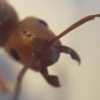2. Date of collection: 5-6-19
3. Habitat of collection: Wooded area next to the river, 9:30 PM and was 75 degrees
4. Length (from head to gaster): 16mm
5. Color, hue, pattern and texture: mostly black, workers seem to have a yellowish band on the gaster and yellow hairs on gaster.
6. Distinguishing characteristics: mostly all black with a little shine of yellow on gaster
7. Distinguishing behavior: very calm, we’re not really running around and after being caught, are just chilling and holding very still for pictures
8. Nest description: inside cottonwood trees
9. Nuptial flight time and date: no flight was ever seen
Queen from the top in blueish light

Queen in “warm white” light

From the side

Closer up from the side

From the other side
























